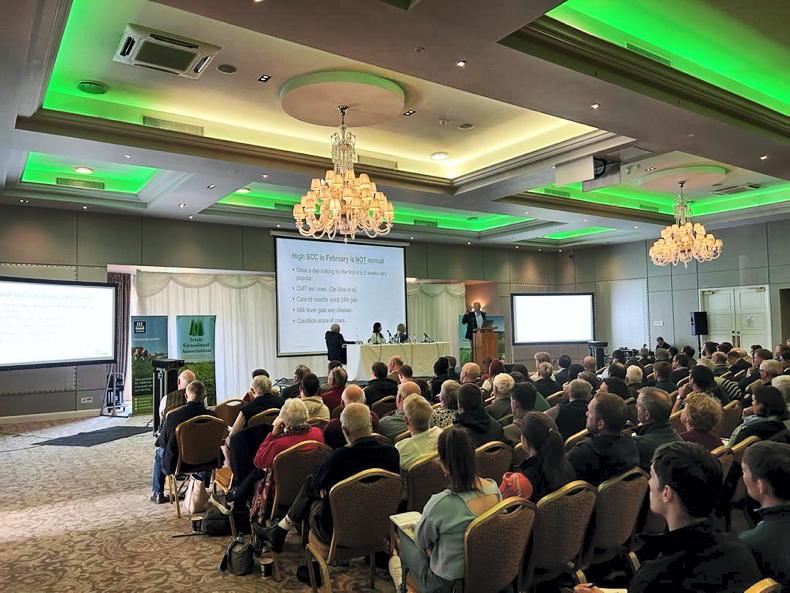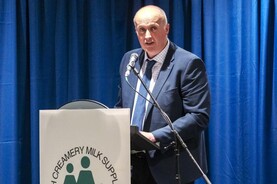Ireland’s dairy industry is built on the tradition of cows grazing outdoors on grass for up to nine months of the year, on mainly family-owned farms. On average, dairy herds spend 240 days at grass, with the top farms reaching 280 days.
With 95% of their diet consisting of grass, the pasture-based grazing system enables Irish dairy to be one of the most environmentally efficient in the world. The 17,000 dairy farms have an average herd size of 91 cows and an average size of 55ha. Ireland has the longest grass-growing season in the northern hemisphere.
This was the message from IFA’a director of policy Tadhg Buckley, speaking at the Irish Grassland Association dairy conference in early January.
Where is Irish dairying today?
Tadhg said that the Irish dairy industry has grown wide and fast since one of the biggest changes in the history of the dairy industry, the abolishment of milk quotas in the 2015-2021 period. The dairy industry grew a phenomenal 41% of milk solids, with cow numbers increasing 24%.
However, in the last two years there has been a plateau in milk production, with 0.5% less production in 2023 when compared to 2021. There are a couple of factors which influenced this, he said, such as the introduction of nitrates banding and a massive cost inflation of inputs. This, in turn, planted the seeds for the end of dairy expansion.
Milk production is set to fall even further, with the reduction of maximum nitrate stocking rates from 250kg N/ha to 220kg N/ha for derogation farmers to come into play in 2024; milk production in 2024 will take yet another fall.
Tadhg reiterated the importance of the dairy sector to the Irish economy, with analysis completed for Dairy Industry Ireland estimating that in 2022 the Irish dairy sector generated circa €17.6bn in direct and indirect economic investment.
Unlike some other major sectors in Ireland, it was noted that most of this money was predominantly retained in Ireland.
The IFA estimates that farmers took on €2.2bn of on-farm capital investment to facilitate this expansion. It must also be noted that debt on Irish farms hasn’t risen since 2015, which shows an incredible strength towards profitability and economic sustainability of dairy farming.
Global milk production
He said that in the Northern hemisphere, the Irish system is unique in the way we can produce milk. Our competitive advantage is our ability to grow large quantities of grass efficiently, due to our temperate climate. Most other leading milk-producing countries are indoor-feeding a total mixed ration (TMR) diet, with the aid of irrigation on many farms.
Something often overlooked is our efficiency to produce milk with low levels of water.
Ireland has one of the lowest water footprints per litre of milk produced in the world, with a blue water footprint of just six litres per litre of milk. A blue water footprint is the amount of water extracted from the ground or surface water.
Comparing this to our competitors, Tadhg said the US needs a total of 77 blue water litres per litre of milk, New Zealand needs 7.8 litres and the Netherlands needs 60 litres.
Our low water footprint is due to both our high rainfall level, low usage of concentrates and the absence of irrigation.
Financial performance
Tadhg said the flat milk supply curve in countries that aren’t seasonal producers commands a higher price due to a constant milk supply, which is soaked up in the higher cost associated with producing milk all year round. When comparing Irish figures to competing countries, it showed Ireland received a 6% less milk price than the EU average between 2017-2021. When total operating costs were compared, Ireland had 18% less costs than the EU average, leading to a more profitable competitive system.
While Ireland has a low cost of production, this is predominantly due to the key differential being pasture-based grazing. If Ireland was to have a system similar to other world-leading countries, the cost of production would be significantly higher, as Ireland is a high-cost economy.
Driven by ongoing substantial foreign direct investment, Ireland’s seasonally adjusted unemployment rate has reached an all-time low of 3.8% in 2023. While this is great, this economic expansion has placed significant impact on the labour market, with the highest minimum wage rate in the EU.
The cost of inputs in Ireland is also very high. Ireland has one of the highest energy costs in Europe, which has an indirect cost through contractors and services.
As most of Ireland’s inputs are imported, with no domestic fertiliser industry, farmers are required to import all their fertiliser. Tadhg said the Irish tillage sector is also relatively small. Protein sources for animal feeds are predominantly imported. If the dairy industry relied more on these inputs, it would not be viable in the long run.

Tadhg Buckley says the derogation must be protected at all costs as the only thing we have that's low cost is grass.
Supply and demand
Tadhg said that for the rest of this decade, there will be substantial environmental pressure impacting milk supply in Europe. The Netherlands, for example, is likely to see a large reduction in supply due to ammonia emissions.
New Zealand will be impacted by a tighter land use policy, which will put a restriction on land use. Many industry analysts are predicting a medium-term negative growth projection for NZ.
The US is predicted to grow in production with much less environmental restrictions compared to the rest of the leading countries. Chinese demand may not be as robust as predicted, with many dairy units starting up in China.
Rabobank predicts demand will still be strong. It is expected that supply will struggle to meet demand globally and analysis projects a 33m-tonne dairy product demand gap in 2030.
What if Ireland loses derogation?
Tadhg said Ireland’s competitive advantage must be protected at all costs. The removal of the nitrates derogation will overnight eliminate the cost advantage farmers hold over other countries. The removal of the derogation would likely lead to a more intensive system, relying more on imported feed and a higher fixed-cost base.
He said there would likely see a lot more out-blocks on farms if the derogation was lost. There would be a lot more silage in the diet, cost of services would increase, with a lot more silage cutting and zero-grazing. Labour would increase to meet the demand of the additional workload from out-blocks and there would be a further reliance on imported feed. However, the milk price disadvantage would likely continue, which makes Ireland a much less profitable and unsustainable country to produce milk.
Ireland’s dairy industry is built on the tradition of cows grazing outdoors on grass for up to nine months of the year, on mainly family-owned farms. On average, dairy herds spend 240 days at grass, with the top farms reaching 280 days.
With 95% of their diet consisting of grass, the pasture-based grazing system enables Irish dairy to be one of the most environmentally efficient in the world. The 17,000 dairy farms have an average herd size of 91 cows and an average size of 55ha. Ireland has the longest grass-growing season in the northern hemisphere.
This was the message from IFA’a director of policy Tadhg Buckley, speaking at the Irish Grassland Association dairy conference in early January.
Where is Irish dairying today?
Tadhg said that the Irish dairy industry has grown wide and fast since one of the biggest changes in the history of the dairy industry, the abolishment of milk quotas in the 2015-2021 period. The dairy industry grew a phenomenal 41% of milk solids, with cow numbers increasing 24%.
However, in the last two years there has been a plateau in milk production, with 0.5% less production in 2023 when compared to 2021. There are a couple of factors which influenced this, he said, such as the introduction of nitrates banding and a massive cost inflation of inputs. This, in turn, planted the seeds for the end of dairy expansion.
Milk production is set to fall even further, with the reduction of maximum nitrate stocking rates from 250kg N/ha to 220kg N/ha for derogation farmers to come into play in 2024; milk production in 2024 will take yet another fall.
Tadhg reiterated the importance of the dairy sector to the Irish economy, with analysis completed for Dairy Industry Ireland estimating that in 2022 the Irish dairy sector generated circa €17.6bn in direct and indirect economic investment.
Unlike some other major sectors in Ireland, it was noted that most of this money was predominantly retained in Ireland.
The IFA estimates that farmers took on €2.2bn of on-farm capital investment to facilitate this expansion. It must also be noted that debt on Irish farms hasn’t risen since 2015, which shows an incredible strength towards profitability and economic sustainability of dairy farming.
Global milk production
He said that in the Northern hemisphere, the Irish system is unique in the way we can produce milk. Our competitive advantage is our ability to grow large quantities of grass efficiently, due to our temperate climate. Most other leading milk-producing countries are indoor-feeding a total mixed ration (TMR) diet, with the aid of irrigation on many farms.
Something often overlooked is our efficiency to produce milk with low levels of water.
Ireland has one of the lowest water footprints per litre of milk produced in the world, with a blue water footprint of just six litres per litre of milk. A blue water footprint is the amount of water extracted from the ground or surface water.
Comparing this to our competitors, Tadhg said the US needs a total of 77 blue water litres per litre of milk, New Zealand needs 7.8 litres and the Netherlands needs 60 litres.
Our low water footprint is due to both our high rainfall level, low usage of concentrates and the absence of irrigation.
Financial performance
Tadhg said the flat milk supply curve in countries that aren’t seasonal producers commands a higher price due to a constant milk supply, which is soaked up in the higher cost associated with producing milk all year round. When comparing Irish figures to competing countries, it showed Ireland received a 6% less milk price than the EU average between 2017-2021. When total operating costs were compared, Ireland had 18% less costs than the EU average, leading to a more profitable competitive system.
While Ireland has a low cost of production, this is predominantly due to the key differential being pasture-based grazing. If Ireland was to have a system similar to other world-leading countries, the cost of production would be significantly higher, as Ireland is a high-cost economy.
Driven by ongoing substantial foreign direct investment, Ireland’s seasonally adjusted unemployment rate has reached an all-time low of 3.8% in 2023. While this is great, this economic expansion has placed significant impact on the labour market, with the highest minimum wage rate in the EU.
The cost of inputs in Ireland is also very high. Ireland has one of the highest energy costs in Europe, which has an indirect cost through contractors and services.
As most of Ireland’s inputs are imported, with no domestic fertiliser industry, farmers are required to import all their fertiliser. Tadhg said the Irish tillage sector is also relatively small. Protein sources for animal feeds are predominantly imported. If the dairy industry relied more on these inputs, it would not be viable in the long run.

Tadhg Buckley says the derogation must be protected at all costs as the only thing we have that's low cost is grass.
Supply and demand
Tadhg said that for the rest of this decade, there will be substantial environmental pressure impacting milk supply in Europe. The Netherlands, for example, is likely to see a large reduction in supply due to ammonia emissions.
New Zealand will be impacted by a tighter land use policy, which will put a restriction on land use. Many industry analysts are predicting a medium-term negative growth projection for NZ.
The US is predicted to grow in production with much less environmental restrictions compared to the rest of the leading countries. Chinese demand may not be as robust as predicted, with many dairy units starting up in China.
Rabobank predicts demand will still be strong. It is expected that supply will struggle to meet demand globally and analysis projects a 33m-tonne dairy product demand gap in 2030.
What if Ireland loses derogation?
Tadhg said Ireland’s competitive advantage must be protected at all costs. The removal of the nitrates derogation will overnight eliminate the cost advantage farmers hold over other countries. The removal of the derogation would likely lead to a more intensive system, relying more on imported feed and a higher fixed-cost base.
He said there would likely see a lot more out-blocks on farms if the derogation was lost. There would be a lot more silage in the diet, cost of services would increase, with a lot more silage cutting and zero-grazing. Labour would increase to meet the demand of the additional workload from out-blocks and there would be a further reliance on imported feed. However, the milk price disadvantage would likely continue, which makes Ireland a much less profitable and unsustainable country to produce milk.







 This is a subscriber-only article
This is a subscriber-only article











SHARING OPTIONS: